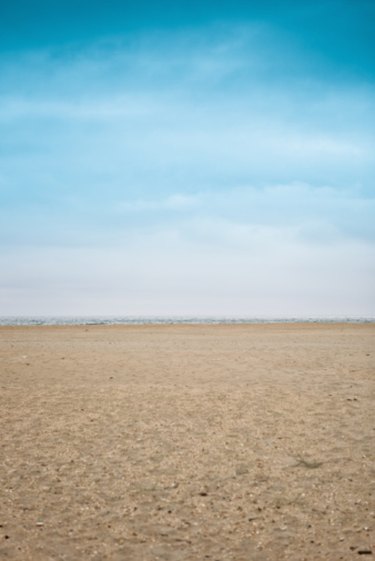
Painting a sandy beach has its challenges. Sometimes a simple thing can turn out to be rather complicated. There are many variables to consider, such as what type of paint you are using. Watercolor requires a different approach than oil or acrylic. Style of painting, application methods and the composition of the painting all have an effect on the final outcome. Following some basic steps will help you use these techniques to enhance your painting.
Application Methods
Video of the Day
Most people use brushes to paint. Painting a sandy beach might require creating minute effects that are difficult to achieve with brushes. Tools to apply these effects could include a sponge dipped in color to create the effects of scattered pebbles and stones, or a toothbrush to flick paint, creating an even finer effect. Realistic shading effects can also be achieved with an airbrush, which can apply color with great precision.
Video of the Day
Composition
This is the most fundamental consideration when creating you painting. A sand beach has particular geographic components that come into play. The perspective of the painting may or may not include the ocean or sun. It may include large waves or just a ripple. Does the view look out to sea, towards the beach or along the shore? You could be painting from the perspective of great height, giving you a birds-eye view, or very close to the ground, requiring the sand to be much more defined.
Sketching
With a composition in mind, it is now possible to sketch out the painting. The horizon must be defined, as well as where the water meets the sand. Distant objects can also be sketched. It is not critical to sketch everything perfectly. Your sketch is just meant as a guideline to help you in the painting process that follows. One very important thing to remember is that the horizon should be a straight, horizontal line. It is best created with a ruler or straightedge. A crooked horizon can undo all the work put into the painting by making it appear unnatural.
Adding Color
Yellow ochre and raw sienna are but two colors that can be used to create the sand beach. Use white and grey for clouds, and paint a blue sky that gets lighter near the horizon. For the ocean, it is common to use green together with various shades of blue. The important thing to consider is the light, and where it's coming from. This determines where the shadows are and how the sand colors shift from light to dark. More realism can be created by extending the beach color into the water and then painting the water color over it up to the intended water line. This makes it appear as if the sand is shimmering through the water.